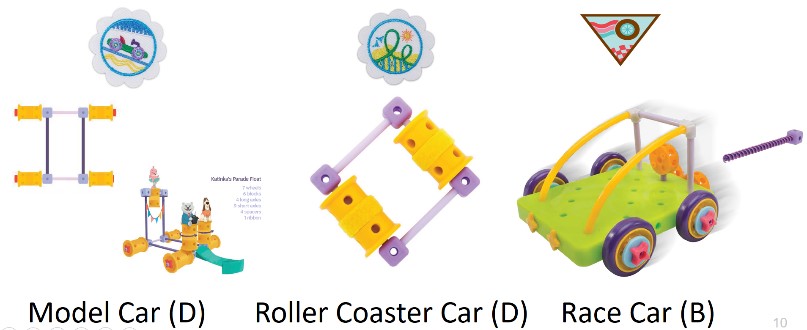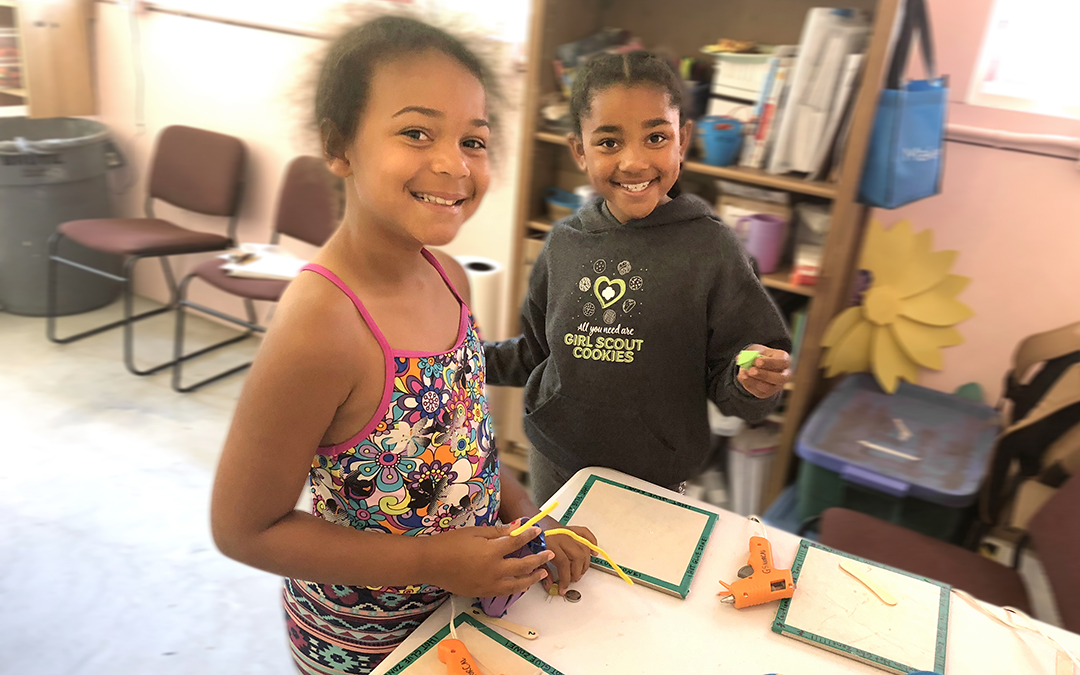Have a problem to solve? Sometimes a machine is the answer! Mechanical engineers design and create machines to meet a special need or solve a problem. Some use their imaginations to invent new things like self-driving cars. Others come up with new and better ways to build things such as bridges, buildings, and planes. What better way to help your girls learn problem-solving skills that help make the world a better place than with one of our Mechanical Engineering badges!
Save it for later!
The Badges
Each of the nine Mechanical Engineering badges consists of a design challenge, where girls build and test a project—the fastest car or the furthest flying glider, for example—over two 90-minute meetings. To solve their design challenge, girls use the Engineering Design Process, which helps girls practice valuable skills such as brainstorming and iteration, a.k.a. thinking up ideas, making improvements, and trying again. As girls complete the badge, they also learn about science concepts such as fair tests, potential and kinetic energy, and the forces of flight.

How to Earn Your Badges
Badges can be earned individually and in any order. For the best experience, use both the girl badge booklets and the Volunteer Toolkit materials. The badge booklets (available in print or digital formats) are full of fun, colorfully-illustrated science concepts and special features that enhance the girl experience, and you’ll need the Volunteer Toolkit meeting scripts for details on how to complete each project.
Daisy and Brownie badges can be completed in two ways: as DIY projects with ordinary household materials, or with turn-key Goldie Blox kits, available to rent from GSNorCal offices. Using your own materials allows girls to be far more inventive, but does take a bit more time to prepare. If you can, try the badge project on your own in advance of doing it with your girls to help better understand how things work together!
Junior badges are available only in the DIY format.
Multilevel Troops Can Engineer Together
Have a multilevel troop? Earn the Model, Race, and Balloon Car badges together! With just a piece of cardboard (car body), a straw (axle holder), a wood skewer (axle), some wheels (bottle caps are free!), scissors and tape, girls can build a rolling car to explore how forces like friction and gravity affect their cars’ performances. Juniors can up their science game by adding thrust, provided by balloons. These cars provide a lot of tinkering (and decoration!) potential, making model, race, and balloon cars some of the most popular activities at the Camp Bothin Maker Zone.


Alternately, rent a Goldie Blox kit with materials to complete the Daisy or Brownie Mechanical Engineering car badges. While there are no Goldie Blox kits for Juniors, a balloon can be added to anything with wheels, as long as girls engineer the balloon to be a bit elevated, avoiding friction with the ground.



Supporting Her Engineering Mindset
As girls build their projects, it can be tempting to fix things for them, but try not to! By helping girls learn to solve their own problems, they’ll build the confidence to help tackle the next challenge. When girls get stuck, use your words, not your hands to help walk them through the issue by asking questions about their thinking and process, like “What did you think you might do next?” and “How did that test go? What ideas do you have for your next try?”
Gentle help with an “I notice…” statement, such as, “I notice your wheels aren’t spinning freely. Is there anything slowing them down?” can help girls start to solve their problem, instead of get upset at their mistakes. Or increase the support with an “I wonder…” statement, such as, “I wonder what would happen if the car had four wheels instead of two?”
Encourage girls to share ideas and solutions by seeing how their sisters have tackled the design challenge! Girls can have their own designs and build on the ideas of others and feel proud not only of their own project, but of their troop’s innovative spirit. Even if the final project turns out not quite right, they should feel proud of their work. Practice makes progress, and in the supportive younger girl troop space, effort, and inventiveness should count as much as results.
As always, be sure to include time for reflection, asking girls how they felt about the challenge, what was tricky, what felt great, and what changes they’d like to try if they did the project again.
The engineering design process is an amazing and highly transferrable way to build girls’ interest and confidence in solving new challenges. Spending three hours earning a Mechanical Engineering badge is a great way to practice the skills to help girls make the world a better place!
What to do next:
- Take your badge work to the next level with the “Think Like An Engineer” Journey!
- Keep learning how the world works with an engineering-focused field trip to Children’s Creativity Museum, and coming soon, the Bay Area Discovery Museum.
- Learn more about all our STEM badges and programs, from programming and robotics to space science!
- Want to explore STEM topics with your girls, but feel that your science and tech skills are a bit rusty? Here are 5 tips to share the wonders of STEM with your troop, no experience required.

Jessica Henricks—Jessica is a STEM Program Manager for Girl Scouts of Northern California, where she develops and supports NASA-funded Girl Scout Stars space science programs and STEAM experiences. She fondly remembers sleeping outdoors for the first time at Girl Scout Camp Hidden Falls. Before joining Girl Scouts, Jessica created resources, media, and events with organizations like the Exploratorium and Maker Media. In her spare time, she enjoys tinkering in the workshop or going for a paddle on the bay.


